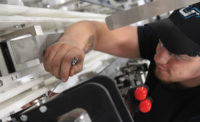Two packaging industry trends are causing headaches for automated case packing original equipment manufacturers (OEMs) and their customers. The first trend involves package light weighting, which makes it difficult to handle more fragile packaging at high speeds. The other trend involves the proliferation of stock keeping units (SKUs) on the same line, lowering throughput due to the changeover time between formats. Solving the light weighting and SKU proliferation issues results in more technically complex machines to build, operate and maintain. OEMs must advance their design strategies to keep the cost of automation affordable so customers continue to receive optimum return on investment (ROI).
The response to light weighting is to rely more heavily on package testing and 3D modeling
Only a few years ago, an OEM could take known package specifications and design and build a case packing machine. With some after-build testing and adjustments, the machine would be ready for shipment to the customer. Light weighting primary, secondary and tertiary packaging has all but ended the build-by-the-numbers practice. Less plastic and fiber in packaging and increasing amounts of recycled content fundamentally change the structural integrity of packages. This affects handling characteristics during case packing.
Today, case packing OEMs must focus more heavily on testing the customer’s packaging to understand the properties the machine will face. They must utilize advanced 3D modeling software during the design of the machine.
Speeding up and simplifying changeover requires a focus on the operator
Cost-effective servo systems have had a positive impact on fast, precise changeover to accommodate the proliferation of SKUs. Even with an advanced level of automation, there may be manual adjustments and/or change parts to be added or removed when a new style of package, case or display tray is on the line. This means that the OEM today must:
- Design the human machine interface (HMI) to be easy to understand and navigate during changeover. HMIs must increasingly rely on photos, video, and other graphics.
- Make it faster and easier for the operator to identify where on the machine adjustments need to be made, the order in which changes are made, and to make those adjustments mechanically easier and more precise.
- Add intelligence to the machine so that it provides operators with feedback during changeover. For example, the machine should ascertain and provide feedback that each operation has been performed properly and the correct parts have been used prior to beginning the next step.
Engineering as a creative endeavor
The proliferation of SKUs requires OEMs to be much more creative problem solvers than in the past. A one-size-fits-all machine builder simply cannot compete any longer. The OEM must not automatically push its solution-of-choice for every occasion but must instead look at the long-term plans for the line and offer an individualized creative solution.
For example, a customer came to Brenton Engineering with a high SKU project. Everyone at the design meeting initially thought that multiple in-feed lines featuring hard automation and a robotic case packer would be the solution. When the design team delved deeper to better understand the long-term space limitation facing the plant and the customer’s plans for new products, it turned out the optimum solution was the opposite: an innovative robotic in-feed orientation of many different packaging formats and fast changeover hard automation to pack them into cases. That solution saved considerable floor space and accommodated a growth in SKUs.
OEMs must be the conduit of information on new solutions
OEMs need to realize that they have an educational responsibility to their customers. They should proactively inform their customers on the merits and the potential drawbacks of new technologies. The customer may not apply this information on the current project but could benefit on the next project or the one after that. This educational role is related to the idea of not pushing one solution over another but instead, fearlessly pursuing the optimum answer. Customers have told Brenton engineers that discussions on industrial computers versus PLCs, wireless sensors, IO-Link enabled sensors, the current realities of Industry 4.0 and the Industrial Internet of Things and the direction that HMI intelligence is going has helped them envision creative solutions, not only for the ever increasingly complex case packing machine, but also automation across the plant floor.













